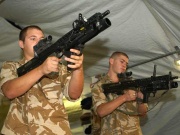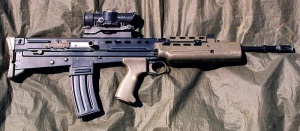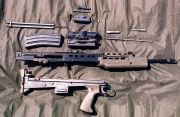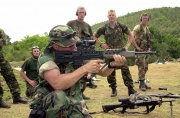SA80
| |||||||||||||||||||||||||||||||||||||||||||||||||||||||||||||
The SA80 (Small Arms for the 1980s) is a family of 5.56 mm small arms designed and produced (until 1988) by the Royal Small Arms Factory at Enfield Lock. In 1988 production of the rifle was transferred to the Royal Ordnance’s Nottingham Small Arms Facility (later British Aerospace, Royal Ordnance; now BAE Systems Land Systems Munitions & Ordnance).
Contents[hide] |
Development
The rifle’s history dates back to the late 1940s, when an ambitious program to develop a new cartridge and new class of rifle was launched in the United Kingdom based on combat experience drawn from World War II. Two 7 mm prototypes were built in a “bullpup” configuration, designated the EM-1 and EM-2. When NATO adopted the 7.62x51mm rifle cartridge as the standard caliber for its service rifles, further development of these rifles was discontinued (the British Army chose to adopt the 7.62 mm L1A1 SLR automatic rifle, which is a license-built version of the Belgian FN FAL).
In 1969 the Enfield factory began work on a brand new family of weapons, chambered in a newly designed British 4.85x49mm intermediate cartridge. The system was to be composed of two weapons: an individual weapon, the XL64E5 rifle and a light support weapon known as the XL65E4 light machine gun. Both designs were based on the 5.56 mm AR-18 assault rifle, which was manufactured in Britain by Sterling Armament Company alongside their similar but improved SAR-87.
In 1976 the prototypes were ready to be trialled, however after NATO’s decision to standardize ammunition among its members, Enfield engineers re-chambered the rifles to the American 5.56x45mm M193 cartridge. The newly redesigned 5.56 mm version of the XL64E5 became the XL70E3. The left-handed XL68 was also re-chambered in 5.56x45mm as the XL78. The 5.56mm Light Support Weapon variant, the XL73E3, developed from the XL65E4, was noted for the full length receiver extension with the bipod under the muzzle now indicative of the type.[1] In this configuration both weapons underwent a series of evaluations, with a small batch of pre-production weapons being used by British soldiers during the Falklands conflict.
Further development out of the initial so-called "Phase A"[1] pre-production prototypes led to the XL85 and XL86. While the XL85E1 and XL86E1 were ultimately adopted as the L85 and L86 respectively, a number of additional test models were produced. The XL85E2 and XL86E2 were designed to an alternate build standard with 12 components different from E1 variants, including parts of the gas system, bolt, and magazine catch. Three series of variants were created for "Environmental User Trials." XL85E3 and XL86E3 variants were developed with 24 modified parts, most notably a plastic safety plunger. The E4's had 21 modified parts, no modification to the pistol grip, and an aluminium safety plunger, unlike the E3 variants. Lastly, the E5 variants had 9 modified parts in addition to those from the E3/E4 variants.[1]
After receiving feedback from users, addressing concerns and incorporating the several design changes noted, including adopting the rifle for use with the heavier Belgian SS109 version of the 5.56x45mm cartridge and improving reliability, the rifle was accepted into service with the British Army in 1985, designated the SA80 (Small Arms for the 1980s). The SA80 family consists of the L85A1 IW (Individual Weapon) and the L86A1 LSW (Light Support Weapon).
In 1994 production was officially completed. Over 350,000 L85A1 rifles and L86A1 light machine guns had been manufactured for the United Kingdom. They are also in use with the armed forces of Jamaica.
Design details
The L85A1 is a selective-fire gas-operated assault rifle that uses ignited powder gases bled through a gas port above the barrel to provide the weapon’s automation. The rifle uses a short stroke gas piston system (the piston travels inside a gas tube located above the barrel) and a three-position adjustable gas regulator; the first gas setting is used for normal operation, the second – for use in difficult environmental conditions and the third setting is used to propel rifle grenades. The weapon uses a rotating cylindrical bolt that contains 7 radially-mounted locking lugs, an extractor and casing ejector. The bolt’s rotation is controlled via a cam pin that slides inside a camming guide machined into the bolt carrier. The weapon fires from a closed bolt.
The rifle is fed from a STANAG magazine, usually with the 30-round capacity. The magazine release button is placed above the magazine housing, at the left side of the receiver.
The L85A1 is equipped with a hammer striking mechanism and a trigger mechanism with a fire-control selector that enables semi-automatic fire and fully automatic fire (the fire selector lever is located at the left side of the receiver, just aft of the magazine). A cross-bolt type safety that prevents accidental firing is located above the trigger; the “safe” setting disables the trigger. When the last cartridge is fired from the magazine the bolt and bolt carrier assembly lock to the rear.
The rifle features a barrel with a slotted flash suppressor, which also serves as the base for attaching and launching rifle grenades and mounting a bayonet.
The rifle is built in a “bullpup” configuration, with a forward mounted pistol grip. The main advantage of this configuration is the overall length of the rifle can be reduced without compromising the barrel length, hence the overall length is shorter than the M4 Carbine, but the barrel length is longer than the M16. However, the adoption of this layout without a conversion kit such as that available for the FAMAS or Steyr AUG, also means the rifle must be used exclusively right-handed since the ejection port and cocking handle (which reciprocates during firing) are on the right side of the receiver, making left-handed firing impossible.
L85A1 rifles used by the Royal Marines, Infantry Soldiers (and other soldiers with a dismounted Close Combat role) and the RAF Regiment are equipped with a SUSAT (Sight Unit Small Arms, Trilux) optical sight, with a fixed 4x magnification and an illuminated aiming pointer powered by a variable tritium light source (as of 2006 almost all British Army personnel deploying on operations have been issued SUSATs). Mounted on the SUSAT’s one-piece, pressure die-cast aluminium body is a mechanical back-up iron sight that consists of a front post and small rear aperture. Rifles used with other branches of the armed forces when not on operations are configured with fixed iron sights, consisting of a flip rear aperture (housed inside a carry handle, mounted to the top of the receiver, replacing the SUSAT sight) and a forward post, installed on a bracket above the gas block. The rear sight can be adjusted for windage, and the foresight – elevation. In place of the SUSAT a passive night vision CWS scope can be used, and also – independent of the SUSAT – a laser pointer can be mounted.
The L85A1 comes equipped with: a sling, blank firing adapter, cleaning kit and a blade-type bayonet, which coupled with the sheath can double as a wire cutter (the sheath contains a small saw). The rifle can be adapted to use .22 LR ammunition with a special conversion kit. The rifle can also accommodate a 40 mm under-barrel grenade launcher.
The weapon’s receiver is made from stamped steel, reinforced with welded and riveted machined steel inserts. Synthetics were also used (i.e. the handguards, pistol grip, butt pad and cheek rest were all fabricated from nylon).
Variants
There are several variants that make up the SA80 'family': the L86A1 and L86A2 LSW, the L22A1 and L22A2 Carbine, the L98A1 Cadet GP (General Purpose) training rifle and the enhanced L85A2.
L85A2
In 2000, Heckler & Koch, at that time owned by Royal Ordnance, were contracted to upgrade the SA80 family of weapons. Two hundred thousand SA80s were re-manufactured at a cost of £400 each, producing the L85A2 variant. Changes focused primarily on improving reliability and include: a redesigned cocking handle, modified bolt, extractor and a redesigned hammer assembly that produces a slight delay in the hammer’s operation in continuous fire mode, improving reliability and stability. The L85A2 can also mount the HK AG36 40 mm grenade launcher in a configuration similar to the M203 grenade launcher. The addition of the grenade launcher adds another 3.30 lb (1.49 kg) to the L85A2's weight.
An additional change has been made to the magazines. There are now two types of magazines, one for blanks (identified by yellow stripes on the magazine) and one for live ammunition. As blank rounds are shorter than live rounds, live rounds will not physically fit in to the blank magazine. Blank rounds will fit into the normal magazine, but their smaller size creates problems with jamming.
From 2007 an upgrade including the provision of ACOG Sights, a new handguard incorporating Picatinny Rails (with optional hand grip/bipod)[2] Rifle and a new vortex style flash hider is being introduced for use by selected units[3]
L86 LSW
The Light Support Weapon (LSW) is a magazine-fed automatic weapon originally intended to provide fire support at a fireteam level. It has a longer barrel than the L85 and a bipod, buttstrap and rear pistol grip, together with a different design of handguard. Its longer barrel gives an increased muzzle velocity and further stabilizes the bullet, giving a greater effective range. The weapon is otherwise identical to the L85 version it is based on and the magazines and some internal parts are interchangeable.
The lengthy, free-floating nature of the heavy barrel and the optical performance of the SUSAT gives the weapon excellent accuracy. From its inception, the L86 has been a target of criticism on much the same basis as the L85 with the additional issue of its inability to deliver sustained automatic fire unlike a belt fed weapon.[4]
The primary use of the LSW has shifted to that of a marksman's weapon within many infantry sections, capable of providing extremely accurate precision fire at ranges of over 600m.[5] The role of a section automatic weapon is instead filled with the FN MINIMI.
The L86A1 was upgraded to the L86A2 at the same time as L85A1 rifles were upgraded to L85A2 standards, undergoing the same set of modifications.
L22 carbine
Based on the L85A1 a compact carbine known as the L22A1 was also developed with a short, 442 mm barrel (the weapon’s weight, with the optical sight – 4.42 kg, length – 709 mm). The forward handguard was replaced with a vertical grip. A smaller version of the SUSAT sight was installed, with the tritium reticule protruded from the top instead of the bottom like the standard issue SUSAT. The newer L22A2 features a Picatinny rail accessory rail instead of the L22A1's fixed front grip. These carbine variants are used in small numbers by vehicle crews, pilots and rear-echelon support personnel.
L98A1 Cadet GP
- Main article: L98A1 Cadet GP Rifle
The L98A1 Cadet GP (General Purpose) is a manually-operated single-fire version of the L85A1 that lacks a gas system and fire selector. The rifle is re-cocked by hand after each shot, using a large cocking handle. This is connected to the bolt by an external rod, and runs on a slide on the side of the body well forward of the working parts. This makes it easier to fire from a prone position. The rifle is equipped with iron sights only. With an appropriate adapter kit it can be used to fire .22 LR rimfire rounds. The L103A1 is a deactivated version of the L98A1 used for drill purposes. It also lacks a flash eliminator, so it cannot be fitted with a blank firing attachment.
L98A1 Cadet DP
Identical to the 'GP' above however there are a few modifications made to it. Firstly the barrel has been filled with lead, the firing pin has been cut and welded down to the bolt face and the hammer has been filed down. All of this is to ensure that the weapon is fully disarmed and would take money and a skilled armorer to rearm it. 'GP' stands for general practice and 'DP' stands for drill practice, the weapons are disarmed so that they may be used by cadets for training, practicing and drill safely without the fear of ND (negligent discharge.) The 'DP' can be identified by a white stripe on the hand guard and near the butt of the weapon with the letters 'DP' in the stripe.
L98A2 Cadet GP
- Main article: L98A2
The L98A2 is the cadet training version of the L85A2 - it differs from the L98A1 in being a semi-automatic rifle (in addition to the other improvements between the A1 and A2 series of the L85).
Deployment

The SA80 gained an initial poor reputation amongst British Soldiers and Royal Marines as being unreliable and fragile, a fact picked up by the UK media,[4] and entertainment industry.[6] The writer and former soldier Andy McNab said in his book Bravo Two Zero, that the British Army procured a "Rolls-Royce in the SA80, albeit a prototype Rolls-Royce."
Some of the rifle's problems were corrected though modifications (e.g. the magazine release guard) but complaints over reliability in service continued.[4] The British Ministry of Defence describes the L85A2 revision as "modified in light of operational experience... the most reliable weapons of their type in the world".[7] Army trials had indicated extremely good reliability over a range of climates for various operational scenarios, though with a decline in reliability in hot, and especially hot and dry conditions.[8] Reports by HK suggested that over-zealous cleaning had a detrimental effect on the rifle. This includes using abrasives on parts not suited to them, as well as simple over-cleaning.
The alleged reliability problems with the SA80 arguably stem from the creation of a precision rifle as a standard battlefield weapon. With the modifications now made, the British Army has an exceptionally accurate assault rifle, able to engage over greater ranges than equivalent arms, at cost of perhaps a more extensive maintenance regime than most similar weapons.
In the mid-90s Venezuela purchased a small batch of these weapons for use by their Special Forces, with the possibility of replacing the aging (but still capable) FN FALs of the entire Venezuelan Armed Forces with the SA80. General discontent with the design and alleged reliability problems, particularly in jungle settings, quickly led to the dismissal of this weapon from all active service within Venezuela.[4]
The SA80 has been used in all conflicts in which the British Army has been involved with since its introduction in the mid-80s. Deployments include Northern Ireland, the First Gulf War, Bosnia, Sierra Leone, the Second Gulf War and Afghanistan.
Users
- Jamaica
- Nepal
- United Kingdom
- Zimbabwe
Resources

This article or section is missing resources, such as diagrams or manual links, and could use more input to fill in the missing bits. You (yes, you!) can help Gunsopedia provide more comprehensive information to our users by using your own knowledge to add to it.
References
- ↑ 1.0 1.1 1.2 The 5.56 X 45mm: 1974-1985 - A Chronology of Development Daniel Watters, The Gun Zone
- ↑ Supply of Handguards and Downgrips for SA80A2 European Defence Agency "The Combat Support Equipment Integrated Project Team (CSE IPT), part to the Ministry of Defence United Kingdom, has a requirement for design, production and supply of a new Handguard and Downgrip for the SA80A2 Rifle to give improved grip capability. There is a possible requirement for up to quantity 8,000 of each item for Urgent Operational Requirements. There is a further possible requirement for up to quantity 15,000 to replace in service equipment."
- ↑ Kit Magazine, Issue 62 Winter 2007 Ministry of Defence "This technology is here now! So if you see strange looking SA80s being carried by strange looking men, then rest assured, those users that had the requirement, had the make-over, at a price."
- ↑ 4.0 4.1 4.2 4.3 Don't Buy British, Guardian Article
- ↑ Light Support Weapon (LSW) Ministry of Defence "With the introduction of the Light Machine Gun (LMG), the LSW will be used for longer range (600-800m), accurate, suppressive fire. It will become the sharpshooter system of the section to out-range any potential threat."
- ↑ for example the Bremner, Bird and Fortune satirical comedy documentary Between Iraq and a Hard Place included the line: "The SA80 is a lethal weapon, especially for the person trying to fire it," stolen from a description of the Vietnam War era M16.
- ↑ UK Ministry of Defence (Army) - SA80 A2 Individual Weapon and Underslung Grenade Launcher (UGL)
- ↑ [1], mirrored at [2]
External links
- Off Target - The Guardian, 10 October 2002. History of the SA80.
- SA80: Mistake or Maligned?
- Modern Firearms - Enfield L85 (SA80) assault rifle
- UK Ministry of Defence (Army) - SA80 A2 Individual Weapon and Underslung Grenade Launcher (UGL)
- Armed Forces - SA80 Text and Images
See also
| [show]This article is part of a series on Bullpup firearms |
|---|




